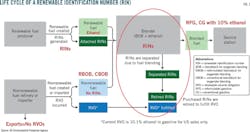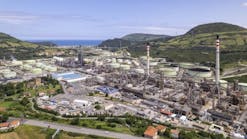Ara Barsamian
Lee Curcio
Refinery Automation Institute LLC
Morristown, NJ
Renewable identification numbers (RINs), part of the US government's program to force the use of renewable fuels, have become a multibillion-dollar burden on refiners and tax on US consumers. In 2016, US refiners paid about $2.2 billion for RIN credits.
Some merchant refiners are on the verge of bankruptcy and laying off hundreds of workers because they must grapple simultaneously with razor-thin margins and extortionate RIN fines. Meanwhile, speculators are driving up the price of RINs, the currency used for the government fines, with mass purchases that create shortage and drive up the RIN price.
RINs are a per-gallon fine on any maker or seller of transportation fuel in the US that does not meet requirements under the Renewable Fuel Standard (RFS) program. This quota, the Renewable Volume Obligation (RVO), is a percentage of the fuel made and sold to the US public. The RVO is determined annually by the Environmental Protection Agency in accordance with statutory mandates.
Increasing every year, the RVO forces the use of several categories of renewable fuel in increasing quantities--even if some, such as cellulosic ethanol, do not exist in meaningful amounts.
The RVO is expressed in RINs, which attach to every gallon of renewable fuel produced at rates that vary with fuel type. One gallon of corn ethanol, the renewable fuel sold in greatest quantity in the US, has 1 RIN attached to it. If the producer sells the ethanol, the RIN goes with it (Fig. 1).
When a refiner physically blends ethanol with gasoline blendstock, RINs are "separated" and count toward meeting the refiner's RVO. A refiner unable to meet its RVO this way must purchase RINs made available by refiners or importers with more RINs than they need. RINs purchased for this purpose are retired from the market.
RIN economics
A look at the RIN cash flow for a typical refiner illuminates the problem. The basis is:
• 1 RIN = 1 gal corn ethanol.
• 1 RIN price ≈ 78¢.
Assuming production of 130,000 b/d of reformulated blendstock for oxygenate blending (RBOB) and conventional blendstock for oxygenate blending (CBOB):
• 2016 RVO at 10.10% = 13,130 b/d of ethanol X 42 gal/bbl = 551,460 RINs/day.
• RIN cost if purchased on the open market to meet 100% of RVO = 551,460 RINs/day X 78¢/RIN = $430,138/day or $157 million/year.
• A refiner can reduce RIN out-of-pocket cost by directly blending ethanol it owns into gasoline it makes. For example, if a refiner blends 1,000 bbl of its ethanol into its 130,000 bbl of RBOB or CBOB, its out-of-pocket RIN costs are reduced by 1,000 b/d X 42 gal/bbl X 78¢ ≈ $32,760/day, or about $12 million/year out of the $157 million/year RVO cost of RINs.
According to news reports, refiners this year will spend more than $15 billion to buy RINs to meet the total 2016 RVO of about 18 billion gal. Approximate expenditures for individual refiners, for example, are Philadelphia Energy Solutions, $250 million; PBF Energy, $320 million; CVR Refining, $200 million; and Tesoro, $1.2 billion.
Options for refiners
Refiners can respond to these pressures in several ways. For example, they can:
• Directly blend ethanol into RBOB or CBOB.
Since ethanol is corrosive and promotes crack corrosion and brittleness, it cannot be blended at a refinery or transported via pipeline, barge, or ship; instead, it is blended at the final distribution point, such as at marketing terminals, truck racks, and truck tanks.
The costs can be prohibitive. The cost of ethanol tanks, piping, metering, dosing equipment, and rack modification can be $1-2 million/terminal. Maintenance can be $500,000/year. Given the alternative of spending hundreds of millions of dollars per year buying RIN credits, expansion of ethanol-handling capacity might be worthwhile.
Unless a refiner owns the ethanol and the attached RINs, it cannot earn RINs by subcontracting blending to a third party.
Complicating this strategy is the blend wall, the ethanol market limit imposed by the auto industry's concerns that ethanol concentrations above 10 vol % will damage engines and increase warranty burdens. Legislated RFS mandates now require more ethanol than the gasoline market can use at the 10% blending limit. The auto industry has taken EPA to court over its solution to the blend-wall problem: raising the blending limit.
• Export as much gasoline as possible to markets where the RFS does not apply.
Gasoline demand is high in regions such as Latin America, West Africa, and Asia, where much of product is conventional and specifications are less strict than in the US. Most of those markets allow processing with cheap, high-octane methyl tertiary butyl ether (MTBE), now banned in the US. Ethanol is used in Brazil at about the 25 vol % level, and other countries are experimenting with modest levels of ethanol. But they have no RVOs or RINs.
• Use higher-RIN fuels, such as renewable diesel and renewable naphtha, which lower volume requirements for meeting ROV quotas.
There are a number of higher-RIN fuels, such as biodiesel made from fatty acid methyl esters (FAMEs), renewable diesel, and renewable naphtha, which have RIN equivalences 1.2-1.7 times that of corn ethanol. Whereas 1 gal of corn ethanol receives 1 RIN, for example, a gallon of FAME-type biodiesel receives 1.5 RIN; of nonester renewable diesel, 1.7 RIN; and of isobutanol, 1.3 RIN.
There are three problems with this approach.
Except for FAME biodiesel and renewable diesel, renewable naphtha and alternatives such as isobutanol are quite expensive and not commercially available in large quantities.
In addition, refiners are limited to using a maximum of 5 vol % biodiesel in commercial auto diesel (ASTM D975). This limits the RINs available via this back door.
A refiner also can maximize RINs by using renewable diesel (hydrogenated vegetable oil, or HVO), which has no established legal limits yet but is limited by density specifications. For example, Neste NexBTL can be used up to 30 vol % in European EN590 auto diesel. In the US, Colonial Pipeline has a specification allowing up to 5 vol % HVO.
• Consider biological ethyl tertiary butyl ether (bio-ETBE), an affordable and recognized renewable fuel, as a blend component.
The European Union is a massive user of bio-ETBE, made with biologically derived ethanol. The substance contains about 47% ethanol; the rest is isobutylene. It thus has an RIN equivalence of 0.47.
Bio-ETBE offers lower overall fuel production costs, volumetric fuel-gain profitability, and transportation and infrastructure cost advantages when compared with fuel-grade ethanol.
ETBE can be blended at the refinery and transported economically via conventional means, including pipelines, barges, and ships. It has highly desirable blending properties, such as 110+ octane and low, 4 psi Reid vapor pressure. It is recognized by EPA and qualifies as a renewable fuel for RIN credit against RVO. It increases the volume of saleable gasoline because achieving the 3.7 wt % oxygen content of 10 vol % ethanol blends requires more than more than twice the volume of additive--22 vol % for ETBE vs. 10 vol % for ethanol. It is 99% less water-soluble than ethanol and thus reduces the risk of contamination from leaky filling station tanks. And it is manufactured economically either by converting existing or mothballed MTBE plants or by building new units. Typical costs are about $30 million for a new, 20,000-b/d ETBE plant and $18 million for converting an existing MTBE unit.
In the US, politics pushed some state governments, such as those of California and New York, to not consider heavy bio-ethers as acceptable substitutes for ethanol. Reconsideration of those policies is in order, as are waivers allowing the use of bio-ETBE.
• Do nothing, and continue paying exorbitant RIN prices to meet RVO quotas.
• Continue advocating for a shift in the RVO point of obligation from refiners to ethanol blenders.
The EPA on Nov. 10 proposed to deny several petitions for a rulemaking that would, in various ways, shift at least some of the RIN burden to parties other than refiners and importers, such as ethanol blenders. At present, blenders are not RVO-obligated entities (Fig. 2).
The shift, like the RFS program itself, is highly politicized. Whether it will occur and succeed or become another avenue for fraud and get-rich-quick scheming remains to be seen.
Heavy burden
Clearly, the RFS and its RVOs have been a heavy burden for US refiners. There is no single solution applicable to all refiners. Not all refiners, for example, can increase fuel exports. And not all refiners can afford to build ethanol-blending facilities.
Juggling the use of higher-equivalency RIN biodiesel, renewable diesel, and other advanced biofuels can reduce onerous RIN costs only by 10-20%, but it's better than doing nothing. Unfortunately, one of the most economic solutions is impractical because of state bans on the use of bio-ETBE.
Refiners addressing the RIN problem need to conduct thorough economic analyses of available options to establish what's feasible and practical for them.
The authors
Ara Barsamian, president of the Refinery Automation Institute LLC (RAI), has over 45 years of experience in gasoline, diesel, and biofuels blending operations and technology. Earlier in his career, he was a group head with Exxon Research & Engineering Co., president of 3X Corp., and vice-president of ABB Simcon, all in the area of fuels blending. Barsamian holds BS and MS degrees in electrical engineering from City University of New York.
Lee E. Curcio, a chemical engineer, has worked with RAI for the past 2 years in the areas of gasoline blending, ethanol nonlinear property correlations and octane boost, and naphtha and butane blending. He also teaches the gasoline blending optimization section of RAI's Gasoline & Diesel Blending public course. He worked previously at Catholic University of Louvain in advanced modeling and optimization. He holds an MS in chemical engineering from Calabria University.




